Archive for the 'Beans' Category
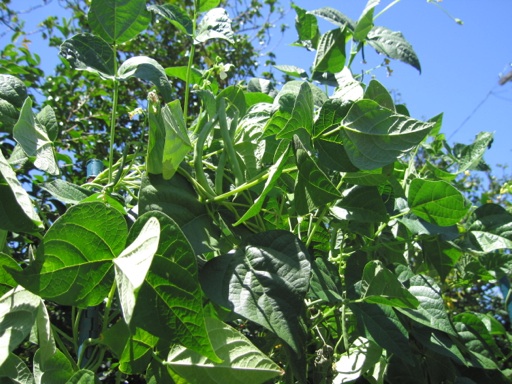
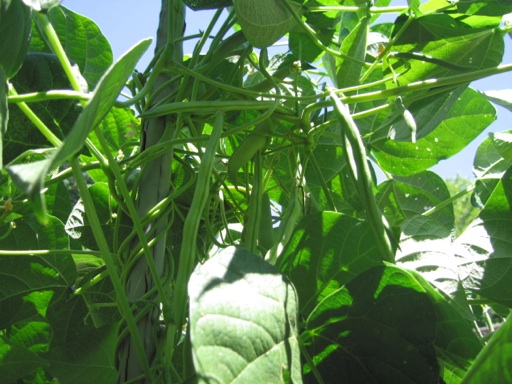
The blue lake beans I planted in March have produced a large amount of beans since late May. I have been picking at least a pound of them about twice per week. Most green beans can get tough and stringy if left on the vine too long. I pick my beans while the bean pods are still slender and the bean seeds inside the pods are not visibly bulging so that we can eat them while they are still tender. After the bean seeds start to get fat and the individual bean seeds inside the pods are distinguishable, they are usually too tough. After bean flowers bloom, the bean pods grow rapidly to full size in about a week. In order to get as many beans as possible while they are still tender but not too small, I have been picking them about twice per week and throwing away the ones that are too fat. I do miss a lot of them, because many are hidden among the leaves.
June 29 2013 | Beans | Comments Off on Prolific Green Beans
Last March around the first of spring, I planted blue lake pole bean seeds and light and dark green zucchini seeds directly into one of our raised beds. I stared harvesting green beans and zucchinis in late May, and they have been producing prolificly since then. This year is the earliest harvest I’ve ever had for beans and zucchini. In the past, my green beans and zucchini didn’t mature until mid-June, and I have always planted them at the same time around the first day of spring. This year’s warmer weather was likely the cause.
Below is a photo of one of my raised beds that has pole beans growing on a wire support in the back, tomatoes in the middle in square cages, zucchini up front, and strawberries growing around the edge. This is the same bed shown in my Apr. 20 post. The plants are close together, which helps to prevent weed growth.
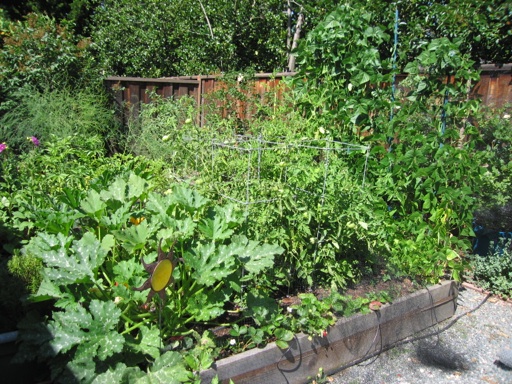
This is a close up photo of one group of my zucchinis:
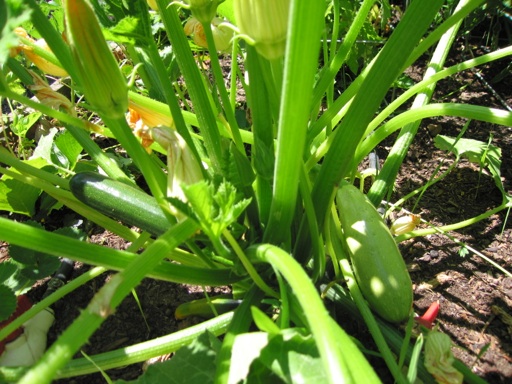
My corn plants are also precocious this year. I planted corn by seed on Apr. 8 directly into another raised bed. The corn seeds took 2 weeks to sprout, but it has been growing rapidly since then. They already are pushing out the tassels.
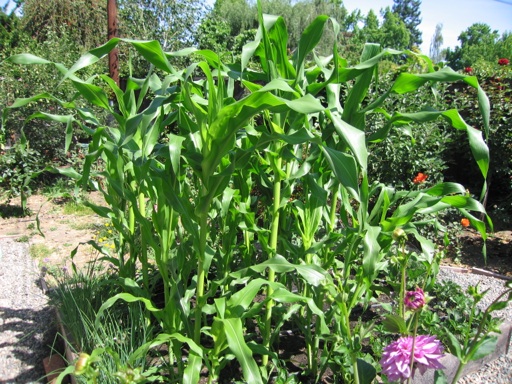
I am experimenting with growing some new edible plants this year. Peanuts are one of the new plants I am growing this year. Peanuts are supposed to thrive in warm summers. I’m not sure it will be warm enough for them here, but I think that it will be fun to try at least once. I purchased peanut seeds through an online mail order website. I planted the peanut seeds in late April. The seedlings look like little pea plants. They are already generating small yellow sweet pea-like flowers. The photo below shows what they looked like earlier today.
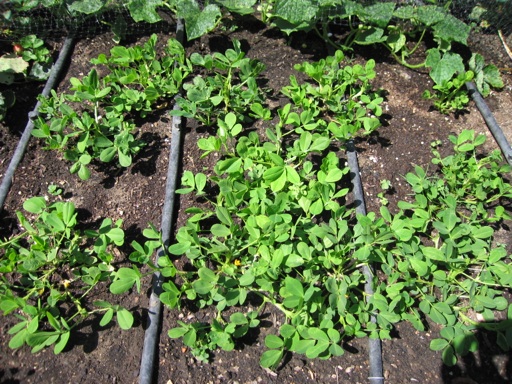
I am also growing spaghetti squash, butternut squash, and sugar pie pumpkins this year for the first time. I planted all of these by seed. I planted the spaghetti squash and pumpkin seeds in late March outdoors in small pots and then transplanted them into the ground after they had sprouted. I decided not to plant them in our raised beds, because their vines grow so long that they would grow out of the beds and along the paths around the beds, which would force me to constantly step over the vines.
Our natural soil here is clay. Our neighbors grew pumpkins successfully in their clay soil last year, which inspired me to try them this year. The spaghetti squash and pumpkin vines are already several feet long and growing rapidly. The photo below shows two spaghetti squash vines with two spaghetti squash on them.
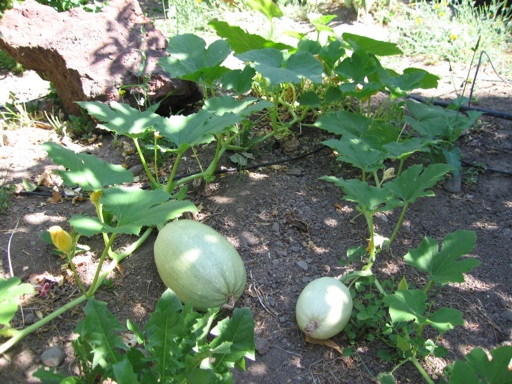
I am growing sugar pie pumpkins rather than jack-o-lantern pumpkins. I want to use pumpkins in cooking, and sugar pie pumpkins are bred for this purpose. Pumpkins are supposed to thrive in climates with relatively mild and dry summers, so they should grow reasonably well here. This is a photo of one of my pumpkin vines with a pumpkin on it:
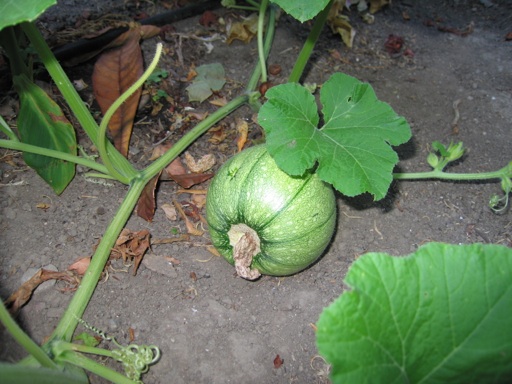
June 15 2013 | Beans and Corn and Peanuts and Pumpkin and Squash and Zucchini | Comments Off on Vegetable Assortment
In March, we added two more raised beds in our backyard. We now have four raised beds that we are growing vegetables in. This year, we are growing tomatoes, potatoes, pole beans, peppers, eggplants, onions, basil, strawberries, cilantro, corn, zucchini, carrots, and cucumbers in our four raised beds. Although we haven’t harvested any vegetables yet, some of our vegetable plants are growing better than others.
Last October, I harvested seeds from dried up bean pods on our pole bean plants. I stored those seeds in a plastic bag over the winter and then planted the seeds in mid-March. Below is a picture of our pole beans today. In nearly 3 months, they have completely covered the fence I built for them last year.
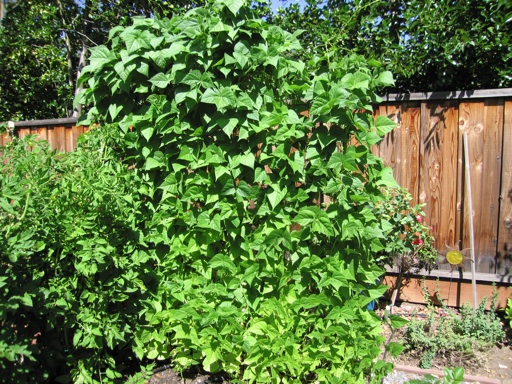
In my experience, pole beans have been really easy to grow by seed and very prolific producers. Nearly all of the seeds sprout without any stratification. And once the beans sprout, they grow quickly with minimal care and little or no fertilizer (at least in our soil which is amended with compost). Although snails and slugs will eat them if they are not protected somehow. Every year that we have grown pole beans (for about the past 4 years), they have produced more beans than we could eat.
Another plant we have had a lot of luck growing is tomatoes. We planted three tomato transplants (early girl, big beef, and champion) in March that we bought from a local nursery. They were about 4 inches tall at the time. They have grown very quickly over the past 3 months, even though the weather here has been much wetter and cooler than average. As shown in the next picture, they have already grown to completely fill their cages.
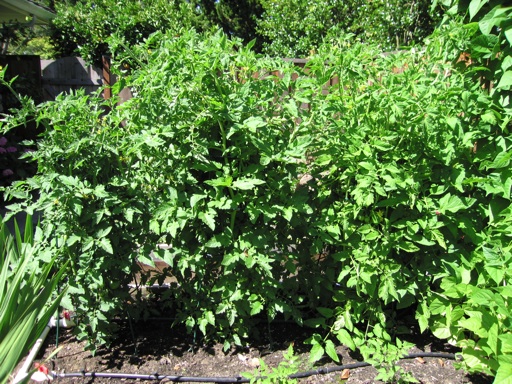
We also planted San Marzano tomatoes by seed indoors a few months ago. Growing tomatoes by seed is a first for us. Nearly, all of the tomato seeds sprouted, but as soon as I transplanted the first batch of seedlings outside in early May, they died. The remaining batches of tomato seedlings I “hardened off” by gradually exposing them to direct sunlight and the outside temperature a few hours a day. After hardening off for about 2 weeks, I planted the remainder of the seedlings outside in our new raised beds. The tomato seedlings I hardened off survived and are looking better, although they are only about 6 inches high now.
Of course, one of the advantages of growing plants by seed is access to a larger number of varieties, many of which are not easy to find as transplants. San Marzano tomatoes are supposed to be great sauce tomatoes. The next pictures shows the two new raised beds we just added in our yard. The San Marzano tomatoes are growing on the left side of the bed in the foreground.
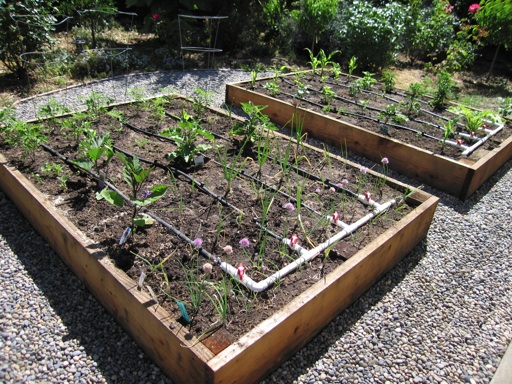
Some of the plants that we haven’t had much luck with this year are onions and leeks. I planted white onion sets, shallot sets, and leek transplants in one of our raised beds in March. The onions and leeks are growing on the right side of the bed in the foreground in the above picture. Although the onions and shallots sprouted, they haven’t grown much, and many of their leaves are turning yellow. The leeks haven’t grown at all since I planted them. I don’t have any idea why they haven’t grown well. But I tend to think that part of the fun of growing is taking a chance on growing new plants and that often means some of those plants don’t end up growing well.
Potatoes are another new plant we added to our garden this year. I planted yukon gold potatoes, which I ordered online as potato sets. I also planted white potato sets, which I purchased from a local nursery. The yukon gold potatoes look wonderful. They have already grown to about two feet tall and have really filled in the space around them (see picture below). The white potatoes sprouted, but they didn’t grow nearly as much as the yukon gold potatoes, so I ended up removing most of the white potatoes to make room for other plants.
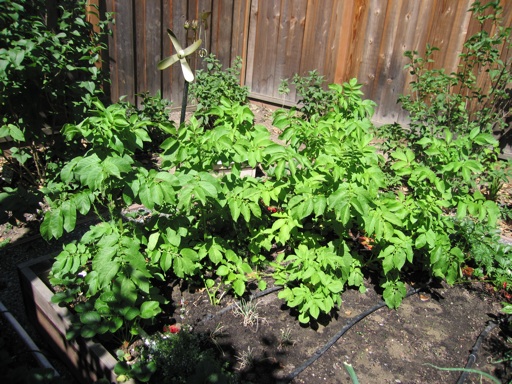
June 13 2010 | Beans and Onions and Potatoes and Tomatoes | Comments Off on Vegetable Garden Successes and Misses
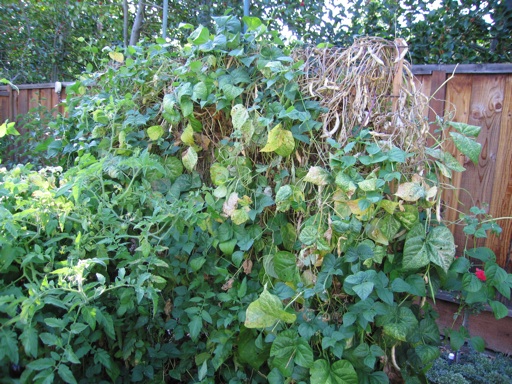
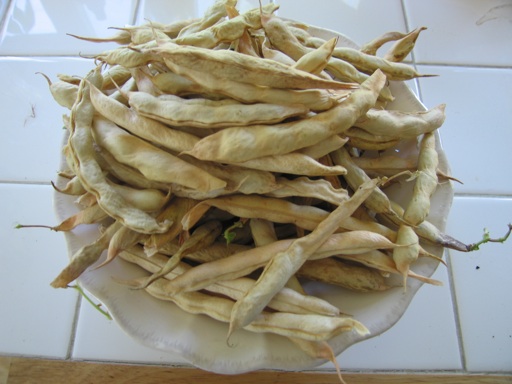
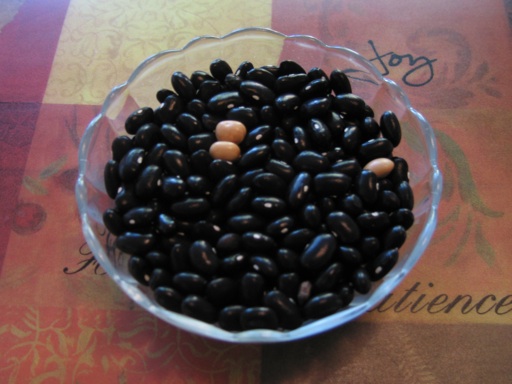
We have been harvesting beans from our pole bean plants since late June. During the summer, they were producing more beans than we wanted to eat, so I didn’t harvest them all. They are starting to wind down their production of beans now, but there are many bean pods left on the vines that have dried up.
Today, I spent about an hour harvesting the dried bean pods and removing the seeds from them. Each fall, I save bean seeds from the dried up beans pods to plant as next year’s crop of pole beans. I place the bean seeds in a zip-locked bag marked with the date I harvested them. Then, I put the bag in a drawer in our kitchen for storage until next spring.
Beans are the only seeds I harvest from our vegetable garden to re-plant for next year. Bean seeds are very easy to harvest, because they are large seeds, and they dry within the pods while they are still on the vine. Other types of vegetable seeds are much smaller and are more of a challenge to pick and dry.
I always make sure to harvest the seeds from bean pods that are completely dried up. The dried up pods crumble in my hands when I break them open. I have noticed that if the bean seeds inside are not completely dry and hard, mildew may start to grow on them while they are in storage.
This year I planted mainly Romano (Italian) beans and some Blue Lake pole beans. The black beans shown in the third picture above are the Romano beans. These types of beans are usually grown for harvest as green beans. But I think the dried black bean seeds from the Romano bean plants can also be cooked and eaten. We have too many dried bean seeds to plant next year in our relatively small vegetable garden, so I am going to try cooking some of them and using them in Mexican dishes.
October 04 2009 | Beans | Comments Off on Harvesting Dried Bean Seeds
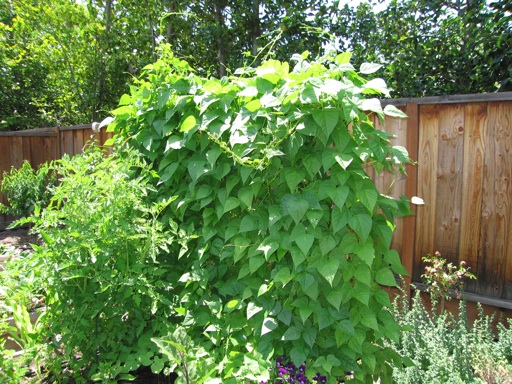
Our pole beans have now completely covered the 5-foot tall wire fence I erected for them last March. I love this fence structure, because it is strong enough to support the weight of the beans. I made the fence using two wooden posts and a steel wire frame that is used for supporting concrete in construction. But perhaps I should have made it taller. The vines are already 8-9 feet long.
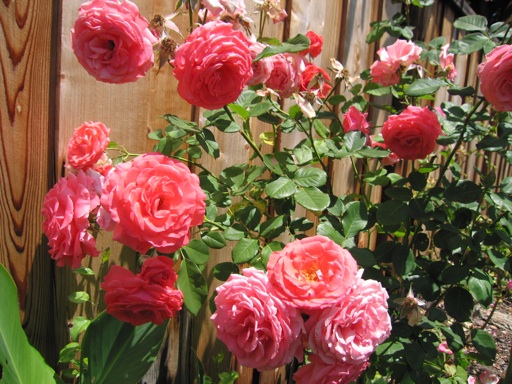
This photograph is a pink climbing rose called America that I planted as a bare root a few years ago. I love this climbing rose. I have planted several climbing roses including Cecil Brunner and Blaze, but this one is my favorite. It has done really well in our yard. It produces lots of beautiful pink flowers, and it has not gotten any black spot or mildew diseases. It grows a moderate amount, but it’s not too vigorous like Cecil Brunner. I got so tried of pruning the numerous long thorny vines of Cecil Brunner, that today I pruned two of ours to the ground, and I plan on uprooting them next weekend.
May 31 2009 | Beans and Roses | Comments Off on Pole Beans and Pink Rose
Next »
















